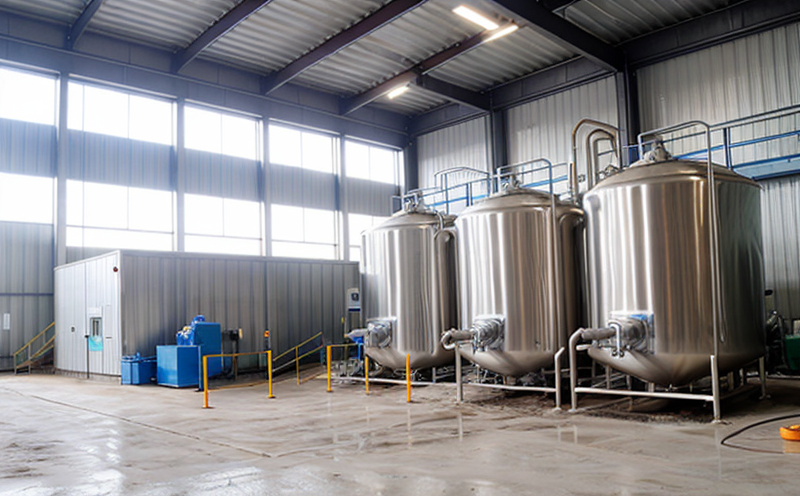ISO 10523 pH Measurement Test in Industrial Water
The ISO 10523 standard specifies a method for measuring pH in industrial water. This is crucial for maintaining the quality and performance of various processes that rely on precise pH levels, such as chemical manufacturing, power generation, and wastewater treatment.
Industrial process waters often contain complex mixtures of chemicals and contaminants which can significantly affect pH stability. The ISO 10523 test ensures that any deviations from specified limits are identified early, thus preventing potential operational issues or regulatory non-compliance.
The standard outlines a series of steps for accurate measurement including the preparation of the water sample according to specific guidelines. It also details the use of appropriate pH meters and reference electrodes, as well as calibration procedures. Compliance with ISO 10523 ensures that the measurements are reliable and can be trusted across different laboratories.
The methodology involves careful sampling, conditioning if necessary, and then measurement at room temperature using a calibrated pH meter. The results should be recorded along with any conditions or adjustments made during the process. Reporting must include details of the sample, the test method used, and the results in terms of pH values.
Understanding the importance of this test can help quality managers and compliance officers ensure that their industrial processes are operating within optimal parameters. For R&D engineers, it provides a reliable baseline for developing new formulations or optimizing existing ones. Procurement teams benefit from knowing they are getting consistent product quality.
| Sample Preparation | Instrumentation | Calibration | Data Recording |
|---|---|---|---|
| Ensure representative sample is taken | Precision pH meter and reference electrode | Regular calibration per manufacturer's instructions | Document all measurements and conditions |
This ensures a robust approach to maintaining water quality, which in turn enhances the overall efficiency of industrial processes.
- Precise pH control can extend equipment lifespan by minimizing corrosion.
- Avoids operational disruptions caused by unexpected changes in process water composition.
- Reduces waste generation and associated costs through optimized chemical usage.
In summary, adherence to ISO 10523 is essential for maintaining the integrity of industrial processes that depend on pH stability. By following this standard rigorously, organizations can ensure consistent product quality and regulatory compliance.
Scope and Methodology
The scope of the ISO 10523 pH measurement test in industrial water includes the determination of pH according to specified methods under controlled conditions. The methodology involves several critical steps:
- Sampling: Representative samples are taken from the process water.
- Conditioning: If necessary, the sample is conditioned by dilution or other means to meet calibration requirements.
- Meter Calibration: The pH meter and reference electrode are calibrated using a standard buffer solution before use.
- Measurement: The pH of the sample is measured at room temperature with the calibrated instrument.
- Data Recording: All relevant data, including the calibration details, measurement time, and results, must be accurately recorded.
The standard emphasizes the importance of accurate sampling to ensure that the measurements are representative of the actual process water conditions. Conditioning steps may be necessary for samples with high ionic strength or other interfering substances that can affect the accuracy of pH readings.
Calibration is crucial as it ensures that the pH meter provides consistent and reliable results over time. The use of standard buffer solutions helps in this calibration, which should be done before each measurement session to account for any drift in the instrument's performance.
The data recording process involves documenting all aspects related to the sample, including its identity, volume, temperature, and pH value at the time of measurement. This detailed documentation is essential for traceability and quality assurance purposes. Compliance with these steps ensures that the test results are accurate and can be relied upon in regulatory and operational contexts.
Use Cases and Application Examples
The use cases for ISO 10523 pH measurement are extensive within the industrial sector. Here are a few key examples:
| Process Area | Purpose of pH Measurement | Expected Outcomes |
|---|---|---|
| Chemical Manufacturing | Ensure consistent reaction conditions and product quality. | Avoid process inefficiencies and ensure compliance with safety regulations. |
| Petrochemical Processing | Control the acidity of refining processes to optimize yield. | Enhance overall efficiency while reducing waste generation. |
| Power Generation | Maintain boiler water quality for optimal steam production. | Prevent scaling and corrosion in boilers, extending their lifespan. |
In each of these areas, accurate pH measurement is critical to maintaining process efficiency, product quality, and compliance with environmental standards. By adhering to the ISO 10523 standard, industries can ensure that their water quality management practices are robust and reliable.
Quality and Reliability Assurance
To ensure the reliability of pH measurements in industrial water, several key steps must be taken:
- Regular Calibration: Instruments should be calibrated regularly according to manufacturer guidelines.
- Data Verification: All data should be verified for accuracy and consistency before reporting.
- Training: Personnel involved in pH measurement should undergo regular training to ensure they understand the latest techniques and best practices.
- Documentation: Detailed records of all measurements, conditions, and calibration details must be maintained.
- Validation: Periodic validation checks can help identify any drift or issues with the measurement system.
Implementing these quality assurance measures ensures that pH measurements are accurate and reliable, thus maintaining the integrity of industrial processes. Regular reviews and updates to procedures based on feedback from experienced professionals in the field further enhance reliability.





